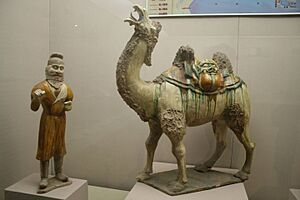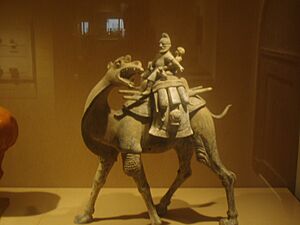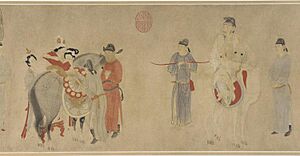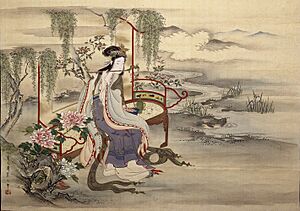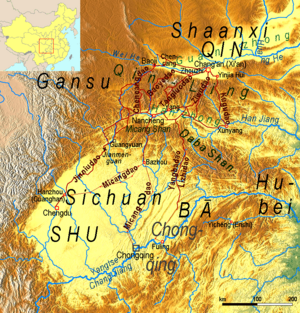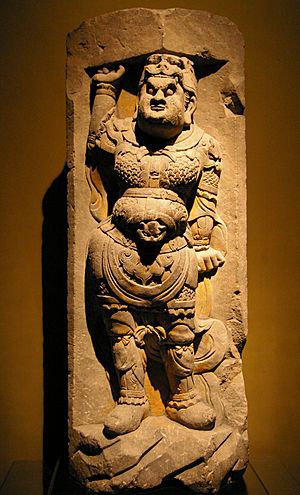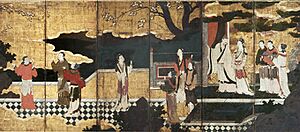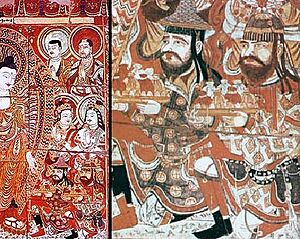An Lushan rebellion facts for kids
Quick facts for kids An Lushan rebellion |
|||||||
|---|---|---|---|---|---|---|---|
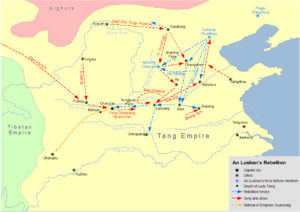 Map of military movements during the An Lushan rebellion |
|||||||
|
|||||||
| Belligerents | |||||||
| Yan dynasty | |||||||
| Commanders and leaders | |||||||
|
|||||||
| Strength | |||||||
| 600,000–700,000 at peak | 200,000–300,000 at peak | ||||||
| Casualties and losses | |||||||
| Heavy but uncertain: see § Death toll | |||||||
| Chinese name | |||||||
| Traditional Chinese | 安史之亂 | ||||||
| Simplified Chinese | 安史之乱 | ||||||
| Literal meaning | An–Shi rebellion | ||||||
|
|||||||
The An Lushan rebellion was a huge civil war in China that lasted from 755 to 763. It happened in the middle of the Tang dynasty (618–907), one of China's most powerful empires. The rebellion started when a powerful general named An Lushan tried to overthrow the Tang government. He wanted to create his own new empire, called the Yan dynasty.
The rebels managed to capture the capital city, Chang'an, forcing the emperor to flee. But eventually, the rebels started fighting among themselves. The Tang dynasty, with help from allies like the Uyghur Khaganate, fought back. The rebellion involved three Tang emperors: Xuanzong, Suzong, and Daizong.
An Lushan led the rebellion for two years before his own son, An Qingxu, killed him. Later, another general, Shi Siming, took over the rebel leadership. He was also killed by his son, Shi Chaoyi. The Yan dynasty finally fell in 763, ending the long and destructive war. This rebellion greatly weakened the Tang dynasty and changed China's history forever.
Contents
- Why the Rebellion Started
- The Rebellion Unfolds
- Rebels Capture Luoyang
- Battle of Yongqiu
- March Towards Chang'an
- The Emperor Flees
- Chang'an Falls to Rebels
- A New Tang Emperor Rises
- Religious Groups Help the Tang
- Siege of Suiyang
- An Lushan's Death and Rebel Leadership Changes
- The Siege of Yecheng
- Shi Siming Takes Control
- Shi Chaoyi Ends the Rebellion
- Aftermath and Legacy
- See Also
Why the Rebellion Started
Political Tensions Before the War
Around 742, many empires across Eurasia faced big political problems. There were major rebellions or changes in who was in charge. For example, the Turkic empire in the eastern steppes was replaced by Uighur rulers. These changes were often linked to merchants and traders involved in the Silk Road.
In 747, the Abbasids started their own rebellion against the Umayyad rulers in the Middle East. This also seemed to be organized by merchants. These events show a time of widespread unrest across different empires.
Tang Empire's Challenges
The Tang Empire had also faced some difficulties. In 751, a large Tang army was defeated in the Battle of Talas by the Abbasids. However, the Arabs didn't advance further, and Tang kept its Central Asian lands for a while.
Tang's expansion south was also difficult due to wars with the Kingdom of Nanzhao. But the Tang were doing better against the Tibetan Empire. It seemed like Tang would win against Tibet, but then the An Lushan rebellion began in China itself.
General An Lushan's Rise to Power
An Lushan was a powerful general with mixed origins, possibly from Sogdian and Turkic families. He became a favorite of Emperor Xuanzong. The emperor even built him a very fancy house in the capital, Chang'an, filled with expensive items.
An Lushan was given control over three important military regions in the north. This meant he commanded a huge army of about 164,000 soldiers. He used this power, along with people's unhappiness with the Tang court, to start his rebellion. He was also very close to the emperor's favorite concubine, Yang Guifei, who even adopted him. Her family members, especially Yang Guozhong, also held important positions, which added to the complex situation.
The Rebellion Unfolds
The An Lushan rebellion caused chaos during the reigns of three Tang emperors. It started with Emperor Xuanzong, continued through Emperor Suzong, and ended during Emperor Daizong's rule. The rebel Yan dynasty also had four different leaders during this time.
Rebels Capture Luoyang
In late 755, An Lushan began his revolt. His army quickly moved from Fanyang (near modern Beijing) and captured the "Eastern Capital" city of Luoyang in January 756. An Lushan treated local officials who surrendered well, so many joined him.
In Luoyang, An Lushan declared himself the Emperor of the new Great Yan dynasty. His next goal was to capture Chang'an, the main Tang capital, and then move south to conquer all of China.
Battle of Yongqiu
However, the rebels faced a tough fight at the Battle of Yongqiu in spring 756. An Lushan's army could not capture Yongqiu (in Henan) or Suiyang from the Tang defenders led by Zhang Xun. This stopped the Yan forces from moving into southern China, giving the Tang time to recover. The rebels only took Suiyang much later, after a long siege.
March Towards Chang'an
Initially, Tang loyalist troops blocked An Lushan's forces from reaching Chang'an. They held strong defensive positions in the mountain passes of Tongguan. But due to some bad decisions at court, the Tang generals there were replaced. The new general was ordered to attack An's army in open ground, which was a mistake. In July, the Tang forces were defeated, and the path to the capital was open for the rebels.
The Emperor Flees
With the rebels close to Chang'an, Emperor Xuanzong decided to flee to Sichuan province. Sichuan was naturally protected by mountains, making it a safe place for the Tang forces to regroup. He took his court and family with him. The journey through the Qin Mountains was very difficult.
During the journey, the emperor's bodyguard troops became angry. They blamed Yang Guozhong, a powerful relative of the emperor's favorite concubine Yang Guifei, for the country's danger. They demanded that Yang Guozhong and Yang Guifei be killed. The emperor had no choice but to agree, and Yang Guifei was killed. After this, Emperor Xuanzong quickly fled to Chengdu. However, people stopped his horse, wanting him to stay. So, he let his son, Li Heng, stay behind. Li Heng then fled to Lingzhou. Later, in August, after reaching Sichuan, Xuanzong gave up his throne to his son, Li Heng, who became the new emperor.
Chang'an Falls to Rebels
In July 756, An Lushan's rebel forces captured Chang'an. This was a terrible event for the once-flourishing capital city. Before the rebellion, Chang'an had a population of nearly 2 million people. Many residents fled as the rebels approached. The city was then looted by the rebel forces, and the people who remained faced great danger.
A New Tang Emperor Rises
Emperor Xuanzong's third son, Li Heng, was declared Emperor Suzong at Lingzhou. One of Emperor Suzong's first actions was to appoint skilled generals like Guo Ziyi and Li Guangbi to fight the rebellion. These generals decided to get help from the Uyghur Khaganate, a Turkic tribe.
With Uyghur help, the Tang Imperial forces successfully recaptured both Chang'an and Luoyang in late 757. However, they couldn't completely defeat the rebel troops, who escaped to their stronghold in the northeast.
Religious Groups Help the Tang
Some religious groups also played a role in helping the Tang dynasty.
- Nestorian Christians, like the priest Yisi from Balkh, helped General Guo Ziyi fight the rebellion. Yisi even acted as a military commander. The Tang dynasty rewarded Yisi and the Nestorian Church for their help.
- Vajrayana Buddhist master Amoghavajra also assisted the Tang. He performed special rituals that were believed to weaken An Lushan's army. Amoghavajra stayed in Chang'an even when it was occupied by rebels, sending secret messages to the Tang crown prince. Because of his help, Esoteric Buddhism became an important state-supported religion in Tang China.
Siege of Suiyang
From early to late 757, a long standoff happened between the Yan and Tang forces at Suiyang. This battle was very important because it stopped the Yan rebels from attacking the rich areas south of the Yangzi River. These southern regions remained mostly safe from the war.
An Lushan's Death and Rebel Leadership Changes

The Tang forces were helped by fighting within the rebel leadership. On January 29, 757, An Lushan was killed by his own son, An Qingxu. An Lushan had become very paranoid and violent, which threatened his own people. His trusted eunuch and another conspirator killed him.
An Qingxu became the new Yan emperor. He was not good at leading and relied heavily on his advisors. He tried to please his generals by promoting them. However, he couldn't control powerful generals like Shi Siming, who started to disobey his orders. An Qingxu's territory began to shrink as many cities returned to Tang control. He became cruel and paranoid, killing generals and their families if they surrendered to Tang.
The Siege of Yecheng
In 757, the Tang prince Li Chu (Emperor Suzong's son), with help from the Huige (Uyghurs), recaptured Chang'an. Tang and Huige forces then moved towards Luoyang. An Qingxu's forces were defeated, and he fled north to Yecheng.
At Yecheng, An Qingxu gathered more soldiers, reaching over 60,000. He tried to get help from Shi Siming, offering him the throne. Shi Siming marched south towards Yecheng. In April 759, Shi Siming fought the Tang forces. A sudden storm caused both armies to panic and flee, ending the siege of Yecheng. An Qingxu and Shi Siming then formed an alliance.
Shi Siming Takes Control
On April 10, 759, Shi Siming killed An Qingxu and became the new Emperor of Yan. Shi Siming quickly recaptured Luoyang. However, his attempts to advance further were stopped by Tang forces.
Shi Siming was known for being cruel and often killed people. He favored his son Shi Chaoqing over Shi Chaoyi and thought about making Shi Chaoqing his heir.
Shi Chaoyi Ends the Rebellion
In spring 761, Shi Siming tried to attack again, but his son Shi Chaoyi failed repeatedly. Shi Siming was very angry and threatened to punish his son. One night, Shi Chaoyi's subordinates convinced him that his life was in danger. They ambushed Shi Siming, captured him, and later killed him. Shi Chaoyi then became the new Yan emperor, but he didn't have much support from other rebel generals.
By 762, Emperor Suzong was very ill. His eldest son, Li Yu, led the combined Tang and Huige forces. On May 18, 762, after his father's death, Li Yu became Emperor Daizong of Tang.
It became clear that the Yan dynasty would not last. Many Yan officers and soldiers started to join the Tang side. In winter 762, Tang forces recaptured Luoyang for the second time. Yan Emperor Shi Chaoyi tried to escape but was caught in early 763. Shi Chaoyi chose to die rather than be captured, ending the eight-year-long rebellion on February 17, 763.
Aftermath and Legacy
The end of the rebellion was followed by a long period of rebuilding and recovery. The Tang government was weakened, and other problems arose. The Tibetan Empire took advantage of Tang's weakness, recapturing some of its Central Asian lands and even briefly capturing Chang'an in 763.
Regional Warlords Emerge
After the rebellion, some former Yan generals, like Li Huaixian, surrendered to the Tang. They were allowed to keep their territories and became powerful regional military governors, known as jiedushi. These areas, especially in Hebei, became almost independent from the central Tang government. This system of powerful regional leaders continued to weaken the Tang dynasty. The Tang also lost most of its control over the Western Regions because troops were pulled back to fight the rebellion. By 790, China had completely lost control of the Tarim Basin area.
Impact on Population and Economy
[[CSS image crop |Image = Yan Zhenqing - Draft of a Requiem to My Nephew.jpg |bSize = 2300 |cWidth = 300 |cHeight = |oTop = |oLeft = 1585 |Location = right |Description = "Traitorous officials did not rescue [them], so a lone town was surrounded. A father and son perished, their nest was flipped and the eggs were crushed ." (metaphor) 「賊臣不救,孤城圍逼,父陷子死,巢傾卵覆。」
— Excerpt from Yan Zhenqing's Draft of a Requiem to My Nephew about the deaths of Yan Gaoqing (Magistrate of Changshan) and Yan Jiming |Link = |Alt = |magnify-link = ]]
The rebellion caused a huge loss of life and displacement of people. Before the rebellion, China's population was around 52 million. After the rebellion, a census in 764 recorded only about 16 million. While these numbers might not be perfectly accurate due to the chaos, they show a massive decline. Many people died from famine, disease, and fighting, or were displaced from their homes.
The rebellion also led to a shift in China's economic power. The northern regions, which had been the heartland, suffered greatly. The economic center moved south to the Jiangnan region, which was less affected by the war.
Treatment of Foreigners
During the chaos of the rebellion, some foreign communities in China faced violence. For example, in 760, a former rebel general who wanted to show his loyalty to the Tang dynasty ordered the killing of foreign Arab and Persian merchants in Yangzhou. Similarly, in Fanyang, another former rebel general ordered the killing of Sogdians, who were Central Asian people. These events show how the rebellion created an atmosphere of distrust and violence against certain groups.
Long-Term Weakening of Tang

The An Lushan rebellion severely weakened the Tang dynasty's central government. Powerful regional military governors gained more control, making it hard for the emperor to rule the whole empire. The Tang government also went into debt, especially to Uyghur lenders who had helped them.
Despite these challenges, the Tang dynasty did recover some of its strength in the decades after the rebellion. They even managed to launch successful military campaigns, like destroying the Uyghur Khaganate in Mongolia in the 840s. However, the rebellion had set the stage for future problems.
The final blow to the Tang dynasty came later with the Huang Chao rebellion (874–884). This rebellion devastated both northern and southern China, something An Lushan's forces failed to do. Huang Chao's army captured both Tang capitals, Luoyang and Chang'an. Although Huang Chao was eventually defeated, the Tang emperors lost all real power to regional warlords. In 907, a former rebel general officially ended the Tang dynasty, leading to a period of division known as the Five Dynasties and Ten Kingdoms period.
Cultural Impact
The rebellion had a huge impact on Chinese culture. Many poets and artists lived through the war and expressed their feelings about the chaos.
- The famous poet Li Bai (701–762) was affected by the rebellion and even exiled for a time. His later poems show his hardships and disappointment.
- Another great poet, Du Fu (712–770), was captured by the rebels in Chang'an but later escaped. His poetry from this time is a key source of information about the massive changes happening.
- Other poets like Wang Changling (698–756?) and Wang Wei (699–759) also experienced the rebellion's direct impact. Wang Wei was forced to serve the rebels for a time.
- Later poets, like Bai Juyi (772–846), also wrote famous poems about the events of the An Lushan rebellion.
The tragic story of Emperor Xuanzong and Yang Guifei became a popular theme for Chinese and Japanese artists. Many paintings show scenes like Yang Guifei bathing or the emperor fleeing to Sichuan. These stories also inspired famous Japanese works, like the Tale of Genji.
See Also
- An Sishun
- Fanyang
- Fubing system
- Jiedushi
- Three Fanzhen of Hebei
|



